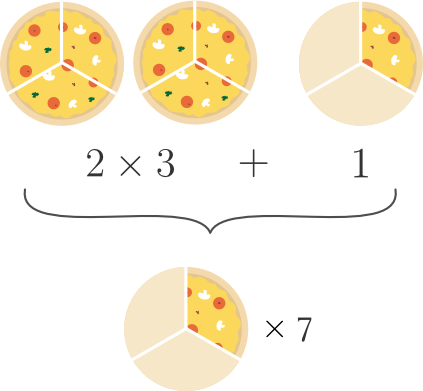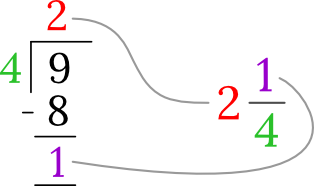A mixed number (also known as a mixed fraction) is a combination of a whole number and a proper fraction. For example - or .
A mixed number (also known as a mixed fraction) is a combination of a whole number and a proper fraction. For example - or .
In a mixed number, you write the whole number first, followed by the fraction part.

We read this as two and one-third, or two, one over three [insert a slight pause between the whole number and fractional parts].
As you may have realized, mixed fractions are used to denote quantities that contain both whole things and parts of a whole.
In the picture below, we have one and a half pizzas on both sides. Now, when we say one and a half, we are talking about the whole (one) and the remaining part (a half) separately. That’s how mixed numbers work.
But there’s also another way of expressing the same quantity.
We could have said three halves of pizzas and that would mean the same thing. Here we are talking about the entire quantity in terms of parts (halves). One whole is made up of two halves, isn’t it?
So mixed numbers can also be expressed as (pure) fractions. And those fractions will always be improper or top-heavy fractions.
Now let’s see how we can convert mixed numbers into improper fractions and vice-versa. It will also help you better understand the relationship between them.
Let me explain using the following example.
Convert the mixed number, , into an improper fraction.
Solution
Here’s an illustration showing how we use the rules mentioned above to convert a mixed number into an improper fraction.

So,
Done.
Say there are pizzas. So, full pizzas and another one-third.
To convert this into a mixed number, we need to talk only in terms of the fractional part — the thirds. So how many thirds of a pizza are there?

Well, each whole pizza has thirds. So there would be times , thirds, in two pizzas. But there’s also the extra one-third. So altogether, thirds. Or pizzas.
Well, that’s exactly what we did in the example above. Didn’t we?
Convert the mixed number, , into an improper fraction.
Solution
Like we did in the last example,
Convert the mixed number, , into a mixed number.
Solution
Step 1. Divide the numerator by the denominator.

Step 2. Write the mixed fraction. The quotient becomes the whole number part and the remainder becomes the numerator. The denominator remains the same as that in the improper fraction.
So,
And thus we have converted the improper fraction into a mixed fraction.
Say you have nine-quarters of a pizza.

So how many whole pizzas can you make out of them? And how many quarters will remain unused?
Well, to make whole pizza, you need quarters. So the real question is — how many times can you take out of (we have quarters), and what will be the remainder?
To find the answer, we divide by .

Now, goes into twice (so whole pizzas) and leaves as the remainder (so extra quarter).
In other words, you have pizzas.
Convert the mixed number, , into a mixed number.
Solution
Like we did in the previous example, we start by dividing the numerator by the denominator.

So,
Negative mixed numbers sometimes cause confusion among students. They have questions like – is the negative sign only for the whole number part only or the entire mixed number? Or how to convert them into improper fractions?
Generally, to perform any operations on mixed numbers, you need to convert them into improper fractions.
Let’s look at a couple of examples.
Simplify -
Solution (a)
Here, we have a subtraction involving a mixed fraction. So we start by converting it into an improper fraction.
And now, it’s the usual case of subtracting fractions.
Note how I converted the answer back into a mixed number. If the question uses mixed numbers and not improper fractions, you must not leave an improper fraction in your answer either. Convert it into a mixed number.
Solution (b)
Again, in the first step, we convert the mixed fraction into an improper fraction. And then proceed to multiply the two pure fractions.
And with that, we come to the end of this tutorial. Until next time.
We use cookies to provide and improve our services. By using the site you agree to our use of cookies. Learn more